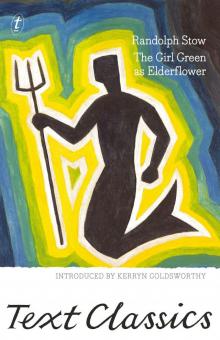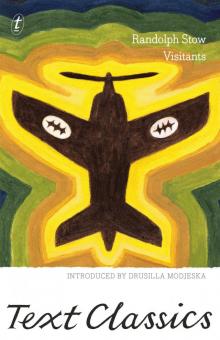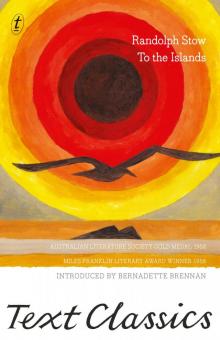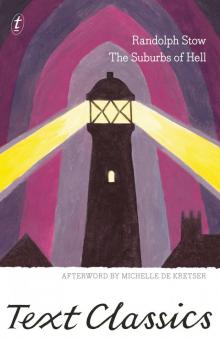- Home
- Randolph Stow
To the Islands
To the Islands Read online
JULIAN RANDOLPH ‘MICK’ STOW was born in Geraldton, Western Australia, in 1935. He attended local schools before boarding at Guildford Grammar in Perth, where the renowned author Kenneth Mackenzie had been a student.
While at university he sent his poems to a British publisher. The resulting collection, Act One, won the Australian Literature Society’s Gold Medal in 1957—as did the prolific young writer’s third novel, To the Islands, the following year. To the Islands also won the 1958 Miles Franklin Literary Award. Stow reworked the novel for a second edition almost twenty-five years later, but never allowed its two predecessors to be republished.
He worked briefly as an anthropologist’s assistant in New Guinea—an experience that subsequently informed Visitants, one of three masterful late novels—then fell seriously ill and returned to Australia. In the 1960s he lectured at universities in Australia and England, and lived in America on a Harkness fellowship. He published his second collection of verse, Outrider; the novel Tourmaline, on which critical opinion was divided; and his most popular fiction, The Merry-Go-Round in the Sea and Midnite.
For years afterwards Stow produced mainly poetry, libretti and reviews. In 1969 he settled permanently in England: first in Suffolk, then in Essex, where he moved in 1981. He received the 1979 Patrick White Award.
Randolph Stow died in 2010, aged seventy-four. A private man, a prodigiously gifted yet intermittently silent author, he has been hailed as ‘the least visible figure of that great twentieth-century triumvirate of Australian novelists whose other members are Patrick White and Christina Stead’.
BERNADETTE BRENNAN is a former senior lecturer in the Department of English at the University of Sydney. Her publications include a monograph, Brian Castro: The Seductive Play of Language, and two edited collections, Just Words?: Australian Authors Writing for Justice and Ethical Investigations: Essays on Australian Literature and Poetics. She is writing a literary biography of Helen Garner and her work.
ALSO BY RANDOLPH STOW
A Haunted Land
The Bystander
Tourmaline
The Merry-Go-Round in the Sea
Midnite: The Story of a Wild Colonial Boy
Visitants
The Girl Green as Elderflower
The Suburbs of Hell
textclassics.com.au
textpublishing.com.au
The Text Publishing Company
Swann House
22 William Street
Melbourne Victoria 3000
Australia
Copyright © Randolph Stow 1981
Introduction copyright © Bernadette Brennan 2015
The moral rights of the authors have been asserted.
All rights reserved. Without limiting the rights under copyright above, no part of this publication shall be reproduced, stored in or introduced into a retrieval system, or transmitted in any form or by any means (electronic, mechanical, photocopying, recording or otherwise), without the prior permission of both the copyright owner and the publisher of this book.
Every effort has been made to trace copyright holders and obtain their permission for the use of copyright material. The publisher apologises for any errors or omissions and would be grateful if notified of any corrections that should be incorporated in future reprints or editions of this book.
First published by Macdonald, London, 1958
Revised edition published by Angus & Robertson, Sydney, 1981
This edition of the revised text published by The Text Publishing Company, 2015
Cover design by WH Chong
Page design by Text
Typeset by Midland Typesetters
Printed in Australia by Griffin Press, an Accredited ISO AS/NZS 14001:2004 Environmental Management System printer
Primary print ISBN: 9781925240290
Ebook ISBN: 9781922253101
Creator: Stow, Randolph, 1935–2010.
Title: To the islands / by Randolph Stow; introduced by Bernadette Brennan.
Series: Text classics.
Dewey Number: A823.3
CONTENTS
INTRODUCTION
Strange Country
by Bernadette Brennan
To the Islands
Chapter 01
Chapter 02
Chapter 03
Chapter 04
Chapter 05
Chapter 06
Chapter 07
Chapter 08
Chapter 09
Chapter 10
Chapter 11
Strange Country
by Bernadette Brennan
RANDOLPH STOW was only twenty-two when he published To the Islands, the haunting tale of an aged missionary on a self-destructive, self-pitying journey towards death. The novel won the Miles Franklin Literary Award in 1958, a year after the inaugural award was given to Voss. You can draw a link between these two novels: not because, as some critics have mistakenly suggested, Stow was working in Patrick White’s shadow, but because both books marked a dramatic shift in Australian writing. White and Stow eschewed realism, sending their protagonists on existential journeys into country that was at once the Australian interior and the tortured landscape of the mind.
To the Islands opens with the old missionary, Stephen Heriot, being roused by an intensity of sound and sensation:
A child dragged a stick along the corrugated-iron wall of a hut, and Heriot woke. His eyes, not yet broken to the light, rested on the mud-brick beside his bed, drifted slowly upwards to the grass-thatched roof. From a rafter an organ-grinder lizard peered sidelong over its pulsing throat.
Oppressed by its thatch, the hot square room had a mustiness of the tropics...Outside, the crows had begun their restless crying over the settlement, tearing at his nerves. The women were coming up to the kitchen. He could hear their laughing, their rich beautiful voices.
The day’s heat is bearing down. Heriot’s books are disintegrating, under attack from insects and mildew. He is exhausted, depressed. His first words, declaiming Baudelaire to the lizard, announce his world-weariness: ‘The sixty-seventh year of my age. Rien n’égale en longueur les boiteuses journées—’ (nothing’s as long as the limping days). Quotations from Baudelaire’s Les fleurs du mal are a form of shorthand in the book to signify questions of doubt and grief, weakness and self-disgust.
Heriot has lost his faith. He rails against a sense of futility and wants to tear down the mission he has devoted his life to building. In his confusion, fury and arrogance he smashes a crucifix, announcing, Lear-like: ‘I believe in nothing.’ Nothingness, in its many manifestations, tolls throughout the novel.
Stow wrote To the Islands after working for some months in 1957 as a ration storeman at the Anglican-run Forrest River Mission, in the far north of Western Australia. Having learned something of the culture, spirituality and language of the Umbalgari people, he sought to honour them, while also affirming what he saw as the important work being done by white Christian missionaries for Indigenous communities in remote Australia. In the 1981 revised edition of To the Islands, Stow removed some of the more heavy-handed ‘propaganda’ that celebrated the missionaries’ role, but considered the rest of the text ‘salvageable’. We should be thankful for that assessment, given that he had banned the reprinting of his two earlier novels, A Haunted Land (1956) and The Bystander (1957). To the Islands, by contrast, has almost never been out of print.
The setting and the focus on Aboriginal culture was groundbreaking in mid-twentieth-century Australian literature. While contemporary readers may baulk at some of Stow’s descriptions and the way Heriot co-opts the Umbalgari language for his corroboree, Stow was one of only a handful of white writers who sought to portray Aboriginal characters with depth and complexity. Katharine Susannah Prichar
d’s Coonardoo (1929) and the books of Xavier Herbert, Vance Palmer and Eleanor Dark went some way to giving Indigenous characters a voice, but it was not until the late 1950s that Stow, White and Judith Wright brought this concern to the literary mainstream.
The Onmalmeri massacre, based on the actual Umbali massacre of 1926, haunts To the Islands. Heriot, who seeks to atone for the historical atrocities of colonialism, instead realises his own culpability. In a fit of rage he casts a stone at Rex, thinking him killed. Disconsolate, he sets out on a journey to ‘the islands’ of the Aboriginal dead. Like so many heroes of European literature, he must experience exile in order to reconcile with himself and with his place in the world.
*
To the Islands is suffused with poetry. While Heriot quotes Gerard Manly Hopkins’ ‘Spring’, it is Hopkins’ great sonnet of religious doubt and despair, number forty-one, that best reflects Heriot’s predicament:
O the mind, mind has mountains; cliffs of fall Frightful, sheer, no-man-fathomed. Hold them cheap May who ne’er hung there...
The monumental, ‘rocklike’ Heriot is physically and spiritually a ‘crumbling cliff’. With the help of his trusted Aboriginal friend Justin, he traverses the rugged country of north Western Australia, with its lush vegetation, teeming wildlife, gushing streams and massive red cliffs. But the most difficult cliffs he must negotiate are those in his mind. Stow projects Heriot’s psychic drama of pride and guilt, atonement and eventual self-discovery onto the canvas of country. The novel progresses through a series of cinematic, cross-cutting scenes. Time and space pull together, then dance apart.
Early critics of Stow’s work were troubled by the way he sought to fuse the symbolic and the real, privileging thought and emotion over action. For Stow, however, spirit and land—the internal and the external environments—are indivisible. He explained in Westerly in 1978:
The boundary between an individual and his environment is not his skin. It is the point where mind verges on the pure essence of him, that unchanging observer that for want of a better term we might call the soul. The external factors, geographical and sociological, are so mingled with his ways of seeing and states of mind that he may find it impossible to say what he means by his environment, except in the most personal and introspective terms...The environment of a writer is as much inside him as in what he observes.
In 2013, while researching an article about To the Islands and Heriot’s quest, I raised with Roger Averill, Stow’s authorised biographer, the idea of Stow’s extreme sensitivity, his heightened appreciation of his environment. Averill responded:
I have long thought that Stow lacked a few layers of skin, allowing him to experience landscape and nature more directly and with greater sensitivity than most of us...I do think the idea of being stripped, at least to the skin, if not deeper, does relate to Heriot and his final declaration. To reach ‘the islands’ and his realisation that his soul is a strange country, Heriot has to be stripped of everything, of all his cultural certainties.
Heriot is highly educated. On his journey he quotes or alludes to a raft of classics: the Bible, Dante’s Inferno, Everyman, Marlowe’s Doctor Faustus, The Pilgrim’s Progress, Shelley’s ‘Ozymandias’, Coleridge’s Rime of the Ancient Mariner, T. S. Eliot’s The Waste Land; and Greek, Latin, German, French and Spanish poetry. Perhaps erudition blinds Heriot to any genuine understanding of himself and his place in the world. Only by shedding that learning, that way of seeing and thinking, can he approach true knowledge. Like David Malouf’s Ovid in An Imaginary Life, Heriot eventually reaches a state of mind beyond language and intellectual understanding: a state of heightened intuitive perception and openness to experience. He discovers the landscape of his soul, a horizon of possibility.
As Stow’s prepositional title indicates, this novel is more concerned with the journey than the destination. There can be no doubt, however, that the Stow scholar Anthony J. Hassall was correct when he noted, in Australian Book Review in 2009, that the closing scene of Heriot ‘alone on a cliff above the Arafura Sea, confronting the strangeness of his soul and looking out towards the Aboriginal islands of the dead, is one of the unforgettable images of Australian literature’. Do the islands exist? Does it matter? Has Heriot found peace? Stow withholds certainty, offering open-endedness over resolution.
Earlier, Heriot and the murderer Rusty debate the possibility of an unforgiving God. When Rusty suggests that God ‘pays us back for what we done’, Heriot insists: ‘We pay ourselves back...Because you know our crimes are like a stone, a stone again, thrown into a pool, and the ripples go on washing out until, a long time after we’re gone, the whole world’s rocked with them.’ As his final act of will, Heriot hurls a boulder into the sea below. While one man may not be able to atone for the sins of a nation, he could set in motion ripples of thought that may reverberate after his death. The novel’s true conclusion may yet lie somewhere far in the future.
I remember first reading To the Islands as an undergraduate in the 1980s. I was amazed at how Stow managed to evoke such beauty and majesty in landscape and people while narrating a tale of such pain and anguish. Like so many readers, I am haunted by the final vision of Heriot and perplexed by his last utterance. Over the years I have taught this novel to hundreds of students and, therefore, had cause to reread it multiple times. Thirty years after my initial encounter with To the Islands, I remain captive to its power.
Revisiting the manuscript of this novel in 1981 an older Stow remarked: ‘Nowadays I should hardly dare to tackle such a King Lear–like theme; but I do not regret having raised the large questions asked here, and so wisely left unanswered.’ He pondered that perhaps the novel retained some interest ‘because this story of an old man is really about a certain stage in the life of a sort of young man’. Today, the reverberations of Heriot’s hurled stone continue long after the covers of this extraordinary novel are closed.
To the Islands
My cell ’tis, lady, where instead of masks,
Music, tilts, tourneys and such courtlike shows,
The hollow murmur of the checkless winds
Shall groan again; whilst the unquiet sea
Shakes the whole rock with foamy battery.
There usherless the air comes in and out:
The rheumy vault will force your eyes to weep,
Whilst you behold true desolation.
A rocky barrenness shall pierce your eyes,
Where all at once one reaches where he stands,
With brows the roof, both walls with both his hands.
Marston: The Malcontent
Still islands, islands, islands. After leaving Cape
Bougainville we passed at least 500, of every shape,
size, and appearance...Infinitely varied as these
islands are—wild and picturesque, grand sometimes
almost to sublimity—there is about them all an air
of dreariness and gloom. No sign of life appears on
their surface; scarcely even a sea bird hovers on their
shores. They seem abandoned by Nature to complete
and everlasting desolation.
Jefferson Stow: Voyage of the Forlorn Hope, 1865
To
SALLY GARE AND BILL JAMISON
with admiration
PREFACE TO THE REVISED EDITION
To The Islands was first published in 1958, and completed not long after I had passed my twenty-second birthday. Understandably, it contains many faults, due partly to immaturity, but more to the fact that my technical competence was not equal to my ambition, which in retrospect makes me realise how horizons narrow in middle age. In reissuing it in this very slightly abridged version, I am conscious that it still asks for the tolerance which most reviewers were kind enough to show when it was new, on the grounds that its author (who no longer seems to be myself) was too young to know his own limitations. Nowadays I should hardly dare to tackle such a King Lear-like theme; but I do not regret having raised the large que
stions asked here, and so wisely left unanswered. If the novel retains any interest, other than as an historical-sociological document, it may be because this story of an old man is really about a certain stage in the life of a sort of young man who has always been with us, and always will be.
In the original edition I was consciously making propaganda on behalf of Christian mission-stations for Aborigines, in particular for one Mission on which I had worked for a short time, and which seemed in danger of closing down. Australian writers before me had generally given missions and missionaries a bad press, and in earlier days some had deserved their low opinion. By 1957, however, the year in which the novel is set, it seemed to me that at least one of them was performing a valuable service to the Aboriginal community which it housed and employed, and which, indeed, it could be said to have created. Though the Government contributed largely to the lodging and education of children, medical services and the rations given to ‘indigents’ (nomads), it could not easily have distributed its charity without the facilities provided by the Church of England and its servants, employed at merely token salaries. It was clear that if the Church felt forced to withdraw its backing from that isolated village, one of only two settlements in a region about the size of Tasmania, the effect on the inhabitants would be disastrous.
For that reason there was in the novel a good deal of talk by the white characters about their difficulties and hopes, and even a very tepid love-interest, introduced not for its own sake but to suggest that at least two Europeans would remain committed to the Mission. Most of those passages have gone now, as the cause was lost long ago. The book did get itself mentioned in the Federal Parliament (‘A brilliant story’, said Hansard), but that was in connection with the alleged need for Professors of Australian Literature. Chairs were duly invented for them; and the Mission, in the late 1960s, was abandoned.

 The Girl Green as Elderflower
The Girl Green as Elderflower Tourmaline
Tourmaline Visitants
Visitants To the Islands
To the Islands The Suburbs of Hell
The Suburbs of Hell